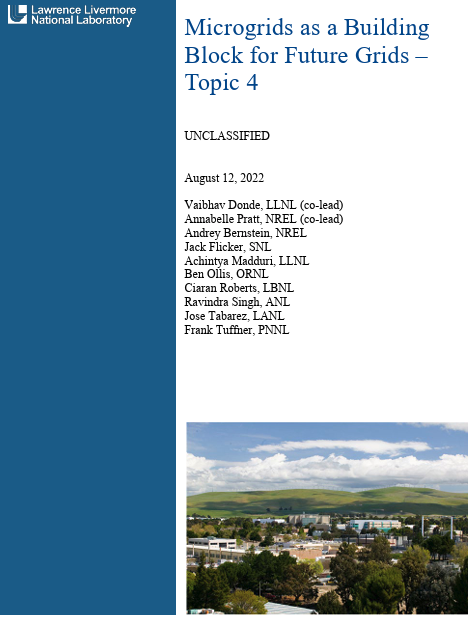
This white paper is the fourth in a series of seven white papers in support of the DOE Microgrid R&D Program and presents a broad vision for future grids where microgrids serve as a building block along with technologies that would need to be developed, use case scenarios and the research targets.
The DOE Microgrid R&D Program vision is to facilitate the nation’s transition to (1) a more resilient and reliable, (2) more decarbonized electricity infrastructure, in which (3) microgrids have a reduced cost and implementation times, while ensuring that microgrids support an equitable energy transition through prioritized provision of at least 40% of microgrid benefits going to disadvantaged communities in a secure manner. These three enumerated strategic goals are developed in the context that the United States’ electricity system is becoming more distributed in nature, and that disruptions to the electricity delivery system (EDS) are occurring more frequently and with greater severity.
The vision statement follows. By 2035, microgrids are envisioned to be essential building blocks of the future electricity delivery system to support resilience, decarbonization, and affordability. Microgrids will be increasingly important for integration and aggregation of high penetration distributed energy resources. Microgrids will accelerate the transformation toward a more distributed and flexible architecture in a socially equitable and secure manner.
The vision assumes a significant increase of DER penetration during the next decade, reaching 30-50% of the total generation capacity.
In that context, the Microgrid R&D program seeks to accomplish these three goals:
—Goal 1: Promote microgrids as a core solution for increasing the resilience and reliability of the EDS, supporting critical infrastructure and reducing social burdens during blue and black sky events
—Goal 2: Ensure that microgrids serve as a driver of decarbonization for the US EDS by acting as a point of aggregation for larger number of DERs, with 50% of new installed DER capacity within microgrids coming from carbon-free energy sources by 2030.
—Goal 3: Decrease microgrid capital costs by 15% by 2031, while reducing project development, construction and commissioning times by 20%.
These goals additionally have cross-cutting topics of focus on equity and security in both R&D and partnered demonstrations. In regulatory R&D and demonstrations, focus will be on supporting an equitable energy transition through prioritized provision of at least 40% of microgrid benefits going to disadvantaged communities. In security, consideration for physical and cybersecurity research, and leveraging or teaming with appropriate entities advancing security through R&D will be considered. This white paper is one of seven being prepared for the Department of Energy (DOE) Microgrid Research and Development (R&D) program as part of the strategy development for the next 10 years. The seven white papers focus on the following areas:
1. Program vision, objectives, and R&D targets in 5 and 10 years
2. T&D co-simulation of microgrid impacts and benefits
3. Building blocks for microgrids
4. Microgrids as a building block for the future grid
5. Advanced microgrid control and protection
6. Integrated models and tools for microgrid planning, designs, and operations
7. Enabling regulatory and business models for broad microgrid deployment
To achieve the three primary goals, the Microgrid R&D Program works in three categories: Category 1: Technology development, Category 2: Analysis and tools for planning, and Category 3: Institutional framework. This white paper, Microgrids as a building block for the future grid, is focused on Topic 4 and falls under Category 1. It presents concepts for how microgrids can become building blocks of the future grid and the value it could bring for electricity grid operation. In tune with this vision, architecture building upon a hierarchical framework is highlighted, where microgrids serve as a building block of the larger grid. It will take advantage of DERs and control technologies available within microgrids to improve system resilience during normal and emergency operating conditions, enhance operational flexibility and contribute to decarbonization in a scalable manner.
